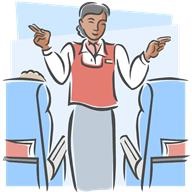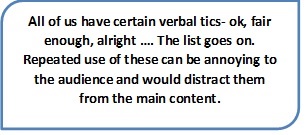Powerful Communication
Nonverbal signals
 Like we mentioned earlier, perhaps the first element to catch the audience’s eye is the nonverbal signals that you convey. Nonverbal signals can vary from gestures to expressions to touch and posture. We shall briefly dwell on some of the important ones.
Like we mentioned earlier, perhaps the first element to catch the audience’s eye is the nonverbal signals that you convey. Nonverbal signals can vary from gestures to expressions to touch and posture. We shall briefly dwell on some of the important ones.
Eye contact is perhaps the most prominent of the nonverbal signals. Avoid talking to the projector screen and make contact with the audience. While it may not be possible to look at each individual, look into the audience and don’t resort to looking at a blank spot in the distant horizon to control your nervousness. Connecting with the audience also gives you a sense of their response, and you will be able to quickly act on the feedback through the body language they convey.
Gestures, again, convey a world of imagination. Use your hands effectively during a presentation to perhaps point to the projector to explain a concept etc. Excessive use of your hands can be distracting. Putting your hands in your pockets, constantly scratching your chin, or head indicates nervousness. Adjusting your clothes often signifies nervousness. Nonverbal signals shown by the audience could be leaning forward showing interest and leaning backwards showing disagreement or boredom. Drumming of your fingers shows distraction. Nodding shows agreement and raised eyebrows show surprise. 
Now that you have learnt how to interpret these signals, you can also consider how you use some nonverbal signals as
a tool to convey a certain emotion or mood to the group. Bend your head forward when someone from the audience
is talking, and walk purposefully up to the participant. Mirror the signals to show similarity as this can help gain empathy.
Learning to read and anticipate the nonverbal cues will help you gauge responses. At the same time, it is important to be aware of
what you are conveying through your body. Your verbal and nonverbal message must be in sync to be accepted totally by the audience.
Adding Variety
What are the various ways in which you can make your presentation memorable? Besides using rich content, how will you add that edge
that makes your presentation stand apart from others?

Listed are some suggestions you could consider:
- Start with a bang - a story, a short performance, a high energy ice breaker, startling statistics anything that immediately hooks the audience.
- Make your session interactive - involve the audience, ask them to relate personal experiences, get them to be creative, involve them in activities.
- Use interesting props like music or puppets. See how you could effectively link them to the content you are using
- Add panel discussions, involve the audience in analyzing data rather than your reeling it out, and allow them to come up with solutions.
- Bring in unusual elements that will add spice to the presentation.
Summary:
- Remember eye contact is the most prominent and important of non-verbal cues.
- Read the non-verbal cues of the group. Keep them in sync with your audience.
Copyright (c) Infosys BPO Limited and/or its licensors, 2014, all rights reserved